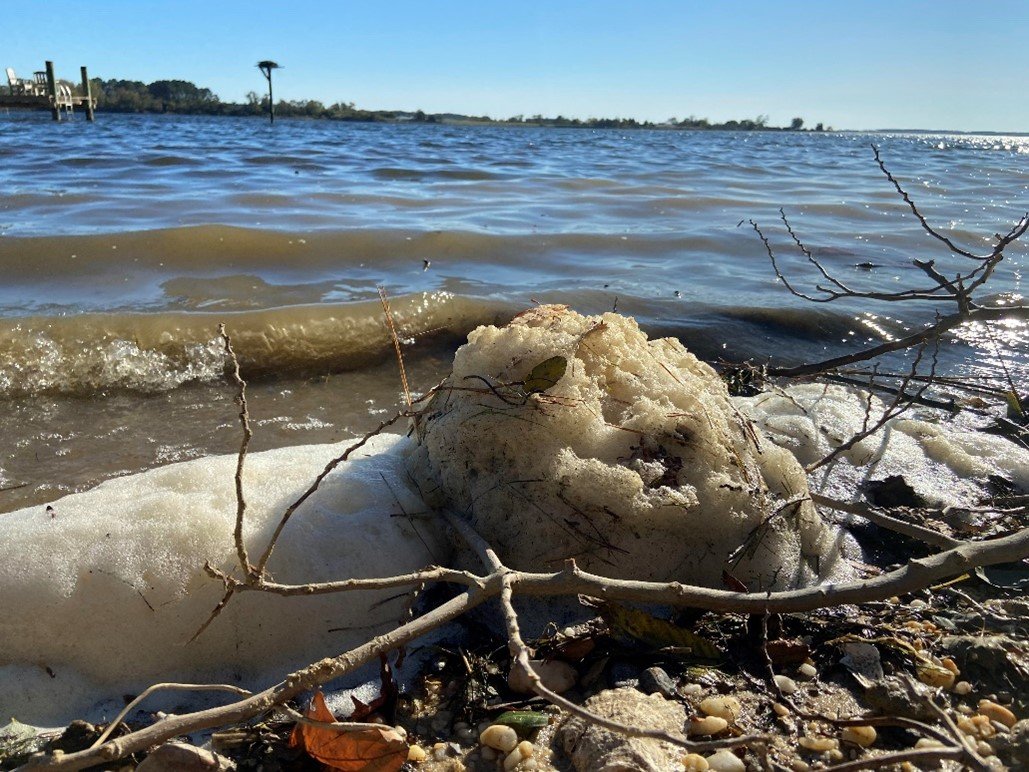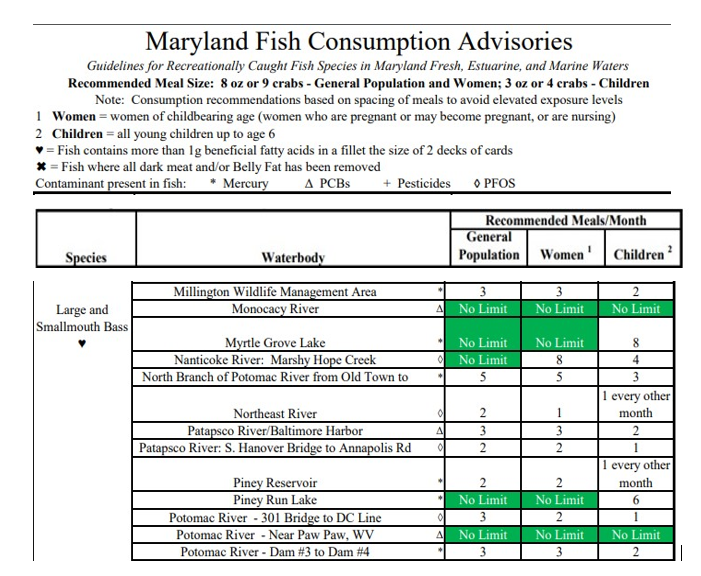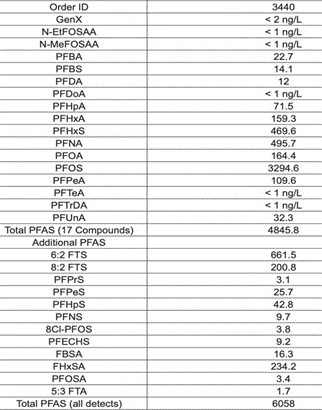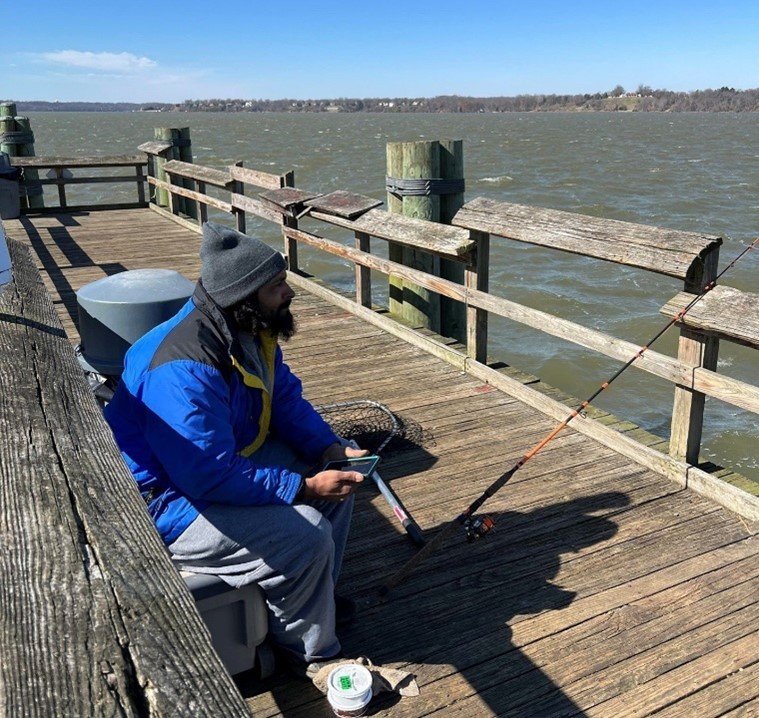Maryland issues PFAS fish advisory that fails to protect public health
Maryland Department of the Environment claims decisions are based on science while nation’s top scientists say otherwise.
By Pat Elder
December 15, 2023
The Maryland Department of the Environment (MDE) has issued a new fish consumption advisory for certain locations based on levels of PFAS for 15 fish species found in Maryland waterways.
The state is allowing the consumption of dangerous levels of the carcinogens in seafood. The MDE is refusing to investigate fish contamination at “point sources,” which are expected to be the cause of contamination in the rivers and the bay. They are only setting advisories on PFOS, when there are many potentially dangerous PFAS compounds that may accumulate in fish. They claim the contaminated Blue Crabs and Oysters have no need for limits.
During a Dec. 7 webinar John Backus of MDE explained “The agency stands by the data they’ve chosen and the science that is supported by EPA.”
Known concentrations of PFOS in Maryland’s fish exceed EPA standards many thousands of times over!
The Oysters
Before examining the current advisory, we must recall the MDE’s chicanery in 2020 when they used unusually high detection limits for PFAS compounds. For instance, see the MDE’s St. Mary’s River Pilot Study of PFAS Occurrence of Surface Water and Oysters, September 2020. This is important to consider because the state did not release data on oysters to substantiate its recent claim that the bivalves throughout Maryland are OK to eat.
The tests performed by Alpha Analytical Laboratory for MDE had a detection limit for oysters at one microgram per kilogram (1 µg/kg) which is equivalent to 1 part per billion, or 1,000 parts per trillion. (ppt.) Consequently, as each PFAS compound was detected individually, the analytical method employed was unable to detect any one PFAS present at an amount of less than 1,000 parts per trillion.
Because the detection limits of the tests performed by Alpha Analytical were so high, the results for each individual PFAS in the Oyster samples were “Non-Detect” (ND). At least 14 PFAS were tested in each sample of oyster tissue, and the result for each was reported as ND. Some samples were tested for 36 different PFAS, all of which reported ND. However, ND does not mean that there is no PFAS!
Leila Marcovici is a scientist, attorney, and chemical patent specialist in New York. She explained, “The analytical methods and basis for the screening criteria used by MDE are questionable, resulting in a misleading of the public, and providing a deceptive and false sense of safety. The MDE’s conclusion over-reaches the reasonable findings based on the actual data collected and falls short of acceptable scientific and industry standards on several fronts.”
Tim Whitehouse with Public Employees for Environmental Responsibility, PEER found 6,650 ppt of total PFAS in backfin Crab meat and 2,070 ppt in Oysters in St. Inigoes Creek, very close to the site of MDE’s testing. The site is about 2,000 feet across the creek from the Webster Field Annex of the Patuxent River Naval Air Station where aqueous film-forming foams were used in routine training exercises for many years. See the results provided by Eurofins.
Whitehouse also tested a Rockfish caught in the St. Mary’s River that contained total PFAS of 23,100 ppt, including 15,000 ppt of PFOS.
The Crabs
“Crabs and oysters have tested below levels of concern,” John Backus of MDE explained during a Dec. 7 webinar.
Maryland Fish Consumption Advisories
MDE says the public may enjoy blue crab from Baltimore city’s waters, although the agency says people should avoid eating the crab mustard.
In 2021 the MDE warned the public to refrain from eating the hepatopancreas, also referred to as the mustard, or “tomalley” in crabs. Today, the ban on eating the delicious crab mustard only applies to crabs caught in the highly industrial areas of Baltimore city. Now its OK to eat the highly contaminated substance “sparingly” everywhere else.
Crab mustard is known to contain potentially dangerous levels of polychlorinated biphenyls (PCBs), Dioxins, Cadmium, Mercury, and PFOA.
Although the MDE isn’t interested in tracking PFOA in crabs or other seafood, the carcinogen is known to accumulate in certain fish species as well as crabs and clams. A South Korean study shows concentrations of PFOA at 16,900 ppt. The levels of PFOA and PFOS were significantly higher in the eggs and hepatopancreas than in the legs and body of the crab. Maryland should be studying this. Clams have been shown to contain 20,000 ppt of PFOA , a concentration that is 5 million times over what the EPA says is potentially dangerous in drinking water.
Other PFAS compounds like: PFDoDA, PFTeDA, PFPeA, PFTrDA, PFUnDA, PFOSA, PFBA, PFNA, PFDA, PFDoA, PFPeS, and 6:2 FTS are known to be present in seafood, sometimes in the hundreds of thousands of parts per trillion. The levels of these toxins may dwarf the PFOS in fish, but MDE isn’t concerned about them.
PFDoDA is dangerous because it is associated with liver disease, cardiac defects, gestational diabetes, and eczema. PFUnDA accelerates the development of diabetes. PFNA and PFDA are closely regulated in drinking water in many states, although not Maryland. They are all believed to be dangerous.
What’s in your seafood, Maryland, and how is it making you sick?
The water
The MDE just published data on surface water. See Part 2 of this series. In 2020 the MDE reported finding two PFAS compounds in St. Inigoes Creek, not far from the burn pit of the Webster Field Annex of the Patuxent River Naval Air Station. They reported 4.33 parts per trillion of total PFAS (PFOA - 2.10 and PFHxS - 2.23). The MDE concluded, “surface water recreational exposure risk estimates were significantly below MDE site-specific surface water recreational use screening criteria.” They provided no description of what this screening criteria entails.
Carcinogenic foam gathers on the beach
directly across from the Webster Field Annex
of the Patuxent River Naval Air Station.
We reported finding 23 PFAS compounds with 6,449.2 ppt of total PFAS, together with a staggering 3,660.9 ppt of PFOS in the foam on the beach, about 2,000 feet from the MDE test site. We have also found 1,894.3 ppt in the water, including 1,544.4 ppt of PFOS shortly after the foam dissipated. It’s noteworthy that MDE’s testing in St. Inigoes Creek showed no results for PFOS.
Sure, we are testing near the shore where the wind, current, tide and waves conspire to create the perfect foam storm.
23 chemicals exist in the creek while the MDE would have us believe otherwise. We must study the fate and transport of PFAS in water.
Maryland’s New Fish Consumption Advisory
Many areas in the state are already covered by fish advisories because of potentially dangerous levels of Mercury, PCBs, and pesticides. For instance, Maryland set a fish advisory limiting consumption of Smallmouth Bass to 3 fish per month for women, based on the levels of mercury found in the fish in the Potomac River.
See the section of the advisory below for fish caught north of Washington, D.C., between Dam 3 and Dam 4 on the Potomac. Antietam Creek flows into the Potomac in this stretch of the river.
Maryland says it’s OK for women who are pregnant or may become pregnant to consume 3 Smallmouth Bass monthly from the river. In 2018 scientists with the U.S. Geological Survey reported finding PFOS in the blood plasma of Smallmouth Bass taken from Antietam Creek where it flows into the Potomac River. The average PFOS level among all 34 plasma samples was 381,000 ppt. The highest PFOS level was 574,000 parts per trillion.
PFOS levels in fish tend to be highest in the blood and livers of fish, with lower levels in their fillets. People often bake, fry, and consume the entire fish, which includes the blood.
In Maryland a pregnant woman may consume 3 servings a month of Smallmouth Bass averaging 381,000 ppt of PFOS.
There is a strong association between PFOS and the overall risk of infectious diseases in early childhood. There is also a strong indication of immunosuppression, with diminished childhood antibody response to vaccination, particularly with PFOS and PFOA exposures. This is why scientists are so concerned about the pregnant women. The chemicals may also cause dangerously high blood pressure levels in pregnant women.
Some frightening math
The EPA says the “chronic reference dose” for a pregnant woman weighing 50 kilos is .00001185 mg of PFOS allowed per month from all sources. Maryland allows .259461 mg of PFOS consumed in fish monthly for our 50-Kilo pregnant woman. Maryland’s advisory is 21,895 times over the EPA’s chronic reference dose. (See calculations at end.)
The math examines the “allowable” reference dose for PFOS. It assumes that the pregnant woman is eating PFOS in fish with no other exposures!
I asked Philippe Grandjean, MD, PhD, adjunct professor of environmental health at Harvard T.H. Chan of Public Health and professor of environmental medicine at the University of Southern Denmark, to look at the math before I presented it here. He said it was correct, assuming that the woman does not get any PFOS from any other source.
I asked Sonya Lunder, the Sierra Club's Senior Toxics Advisor for the Clean Water, Toxic Chemicals, and Climate Resilience Program about this and she agreed with Dr. Grandjean.
Fish are such a major source of exposure that the “relative source contribution” of drinking water or other sources is minimal. We ought to know the relative source contribution (RSC) the MDE used to develop its fish advisories. Some European studies suggest up to 86% of the PFAS in our bodies comes the fish. Perhaps the MDE will somehow argue that just a tiny amount of overall PFOS consumption comes from the fish?
Their position is untenable. It is indefensible. They ought to follow the science.
The same topic came up during the MDE’s online session on December 7, after a colleague asked about the levels of PFOS in fish compared to the low maximum contaminant levels (MCL’s), being mulled by the EPA in drinking water. John Backus replied, “It’s important to note that the MCL is for drinking water, and it is totally not related but it’s still important in informing the state what our PFAS burden is. So, that criteria obviously could change. You know, there’s been some proposals by EPA that have a different drinking water number. It’s different. It is as simple as that.”
I asked Linda Birnbaum, the former Director of the National Institute of Environmental Health Sciences (NIEHS) and the National Toxicology Program (NTP) if this sounded right. She didn’t think so. "Oral is oral," she explained. “Both are routes of ingestion. Whether you eat it or drink it, PFAS go to the same places in the body and do the same thing. We need appropriate fish advisories and regulations,” she said.
MDE now says the public should not consume Largemouth Bass from Piscataway Creek
but it’s OK to eat them from the Potomac River.
Breaking News: Largemouth Bass fail to recognize the line between the creek and the river. – graphic by Nell Elder
(Results are in ug/kg = parts per billion.) In 2020 the MDE reported a Redbreast Sunfish in Piscataway Creek contained 430,960 parts per trillion of total PFAS with 417,000 ppt of PFOS. PFHxS, PFDA, PFUnA PFDoA, and PFTrDA were also detected. The high levels attracted public scrutiny. The new advisory data only covers PFOS.
The MDE’s original Piscataway Creek advisory from two years ago said it was OK for a pregnant woman to consume three Largemouth Bass caught in the creek monthly. At that time the state reported the Largemouth Bass caught where the creek empties into the Potomac had a concentration of 94,200 ppt of PFOS in its filet.
The sediment and the water in the creek are loaded with PFAS. Invertebrates feed on the sediment. The Redbreast Sunfish consume the invertebrates. Largemouth Bass consume the Redbreast Sunfish, and we eat the Largemouth Bass.
The Largemouth Bass tested by the state was about 8 miles from the burn pit on Joint Base Andrews. The MDE reported finding 3,452.5 ppt of total PFAS in the creek near the base.
Now the MDE says it’s OK for women to consume two servings of Largemouth Bass while men may consume three in an advisory that covers waters adjacent to Piscataway Creek in the Potomac River from the DC line to the Rt 301 bridge.
These fish are likely to contain PFOS at levels that are many thousands of times higher than what the EPA says is safe.
Aside from Joint Base Andrews there are many areas of expected “point sources” in the river. The MDE was asked during its recent online session if any fish sampling was carried out at point sources when high levels are found across several fish species at a specific area.
John Backus of MDE replied, "That is beyond the scope of this conversation, but I can tell you that our first advisory came out in the Piscataway and there is a known source. That was an obvious one. In other places we have suspected sources, but that would be another group looking at that, not the fish consumption group. Aside from the Piscataway, no results we have seen have come back so significantly high that we've done any intensive survey or investigation of the source."
Aside from Joint Base Andrews, MDE has refrained from analyzing fish near these installations. To its credit, however, the agency has analyzed water samples near several bases and the results clearly show alarming contamination. We will examine the fish data and the data on surface water in an upcoming report.
Chesapeake Bay
The MDE did not issue a single advisory for PFOS for any species in the Chesapeake Bay, while we know the bay is loaded with the chemicals.
We know the Patuxent River Naval Air Station sent 2,500 gallons of aqueous film-forming foam 2 miles into the Bay in 2021. We know a stream at the Naval Research Laboratory – Chesapeake Bay Detachment in Chesapeake Beach Maryland is pouring out 6,058 of a total of 23 PFAS compounds with 3,294 ppt of PFOS into the bay. See the graphic.
We know Fort George Meade is contaminating the Little Patuxent River with 2,306.2 ppt of PFAS. The river drains into the Bay. We found 459 ppt of total PFAS with 84.5 ppt of PFOS draining into the Little Magothy River from Bay Head Park in Annapolis. The site was once a Navy weapons testing center.
The Army just released data showing PFOS concentrations at 64,000 ppt in groundwater with 115,850 of total PFAS at the Aberdeen Proving Ground. Groundwater often finds its way to surface water, especially in this most fragile area of the Bay.
This is all significant because PFOS bioaccumulates wildly in aquatic creatures. The bioaccumulation rate may be up to 2,000 times greater than the concentration in the water, so fish may contain tens of thousands of ppt of PFOS. One fish near the burn pit at Wurtsmith Air Force base in Michigan had 10 million parts per trillion in its fillet.
The Navy, Air Force, and the Army continue to contaminate Maryland’s rivers and the bay with these powerful chemicals that never go away.
The Town of Chesapeake Beach reported in 2021 that Rockfish and Perch caught from the bay were contaminated with PFAS. The town reported that a Perch contained 9,470 ppt of total PFAS, including a dangerous level of 7,400 ppt of PFOS. The town said an Oyster contained 1,060 ppt of PFAS. Shouldn’t people be advised about consuming oysters and rockfish from the Bay? A rockfish caught in the St. Mary’s River near the bay was found to contain 23,100 ppt of total PFAS, with 15,000 ppt of PFOS.
Dangerous propaganda
The MDE claims, “If a person were to eat more than the recommended meals every month for 30 years, then they have an increased risk of 1 in 10,000 of having a health outcome due to that level of consumption.” This is reprehensible. Where’s the science?
Fishing for Largemouth Bass where Piscataway Creek flows into the Potomac River. “We fry it up.”
Maryland Department of the Environment Secretary Serena McIlwain says the agency is committed to informing “subsistence anglers in underserved communities to make informed decisions about what they and their families eat.” It sounds nice, but the initial Piscataway Creek advisory was promulgated two years ago while the state failed to post a single sign that we saw in many trips to various fishing spots. We spoke with dozens of these folks, and no one knew the fish were contaminated.
Here's the math showing MDE’s advisory is not scientifically based.
Maryland says a pregnant woman may consume three 8-ounce servings of Smallmouth Bass monthly from the Potomac River north of Washington.
The USGS reported that the average Smallmouth Bass contained a concentration of 381 ng/g (nanograms per gram) of PFOS.
381 ng/g x 227 g (8 ounces) = 86,487 nanograms of PFOS.
86,487 ng x 3 fish = 259,461 ng of PFOS monthly.
Maryland says consuming 259,461 ng of PFOS monthly is OK for a 50-kilo pregnant woman.
259,461 ng = .259461 mg
Maryland says .259461 mg of PFOS is OK for a pregnant woman weighing 50 kilos to consume monthly.
The EPA says the Chronic reference dose is 7.9E-9 mg/kg/day for all sources of exposure, not just the fish.
.0000000079 mg / 1 k x 50 K / 1
The EPA says .000000395 is mg per day of PFOS for our pregnant woman weighing 50 kg
.000000395 mg per day x 30 days = .00001185
EPA says .00001185 mg PFOS is allowed per month
Maryland says .259461 mg of PFOS is OK monthly for our 50-Kilo pregnant woman.
.259461 / .00001185 = 21,895
Maryland’s advisory is 21,895 times over the EPA’s chronic reference dose.
The Downs Law Group helps us pay the bills. Their support allows us to research and write about PFAS contamination in Maryland and around the world.
The firm is working to provide legal representation to individuals in the U.S. and abroad with a high likelihood of exposure to trichloroethylene, PFAS, and other contaminants.
The Downs Law Group employs attorneys accredited by the Department of Veterans Affairs to assist those who have served in obtaining VA Compensation and Pension Benefits they are rightly owed.
If you spent time in the military and you think you or your dependents may be sick as a result of your service, think about joining this group to learn from others with similar issues. Are you interested in joining a multi-base class action lawsuit pertaining to illnesses stemming from various kinds of environmental contamination?
Join the Veterans & Civilians Clean Water Alliance Facebook group. (2.5 K members and growing rapidly.)













